From saints to sailors, distilleries to demesnes, County Offaly has it all — including an inspiring resilience, writes Domhnall O’Donoghue
Exploring Tullamore, County Offaly’s principal town, I’m reminded of the fire that destroyed over 100 homes here in 1785 — the result of a wayward hot air balloon colliding with a chimney in what is thought to be history’s first air disaster.
Despite the resulting devastation, Tullamore channelled its inner phoenix and, quite literally, rose from the ashes before commencing the rebuilding. Fittingly, the town’s coat of arms is this mythological bird, which symbolises resurrection and life after death.
This fighting spirit is also evident in the history of the town’s most famous export — Tullamore D.E.W. Established in 1829 — and named after the initials of Daniel Edmund Williams, the stable-boy-turned-distiller, instrumental in its success — this local whiskey ceased operations in the town in the 1950s before being transferred to County Cork.
However, after Scottish company William Grant & Sons purchased the brand, Tullamore D.E.W has finally returned home, phoenix-like — bringing with it a stunning, multi-million distillery and visitor centre. Today, this potent tipple is the second best-selling Irish whiskey globally, with north of 1,500,000 cases sold annually.
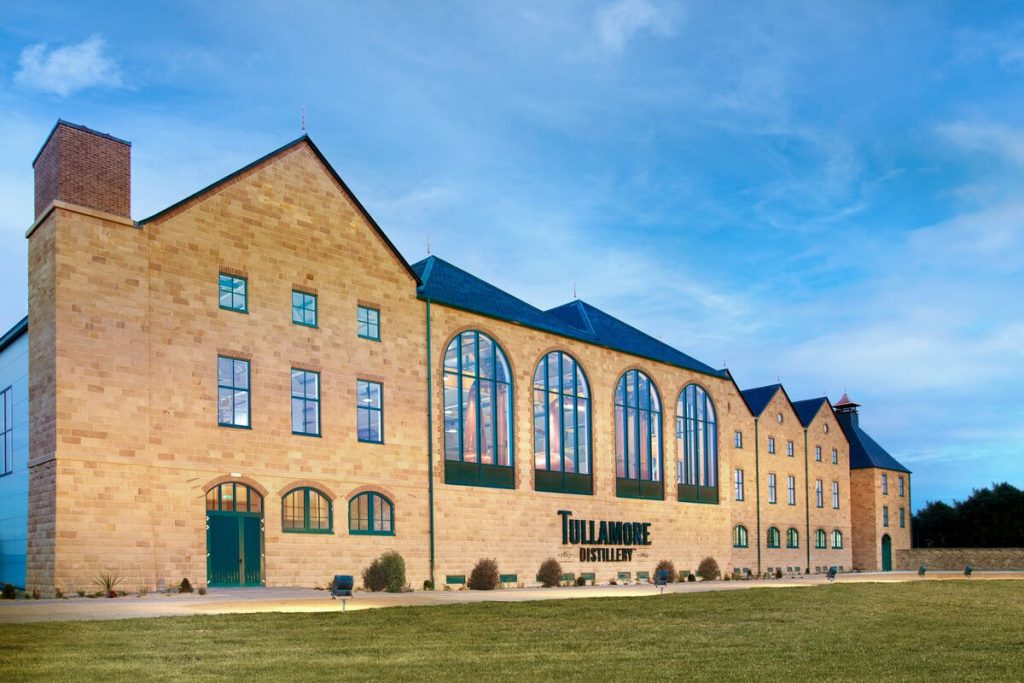
SLÁINTE!
Despite the early hour, staff member Vivienne begins the bespoke tour of the innovative premises with an Irish Coffee, using the long-accepted quartet of ingredients — whiskey, coffee, sugar and cream.
Over 90 minutes, I sip this heavenly concoction and glimpse Tullamore D.E.W.’s meticulous distilling process — admiring the distinctive copper pots and sweet-smelling warehouse, where rows of oak barrels kiss the ceiling.
Vivienne reveals that the missionary monks are to thank — or blame — for introducing whiskey to the world. They returned to Ireland from Europe in the 11th and 12th centuries and shared their newly acquired distilling skills, which were later used to create an elixir known as the Water of Life — or Uisce Beatha in Gaelic. Pronunciation of this term was difficult for the non-natives, she adds — so, over time, it was simplified to fuisce and, eventually, whiskey.
“The rest, as they say, is distilling history.”
A HEAVENLY SITE
Liquor aside, County Offaly has a long and thrilling relationship with monks, perfectly demonstrated by the sixth-century monastic site Clonmacnoise, which has welcomed pilgrims for 1,500 years. Overlooking bogland and the banks of the Shannon, Clonmacnoise — meaning Meadow of the Sons of Nós — was founded by Saint Ciarán in 548.
The strategic location at the crossroads of Ireland resulted in the site becoming a major centre of religion, craftsmanship and trade — not to mention education, evidenced by the many noteworthy manuscripts written here, including the Annals of Tigernach and the Book of the Dun Cow. In fact, according to staff member Kathy, “Clonmacnoise could be thought of as Ireland’s first city — as well as one of the world’s first universities.”
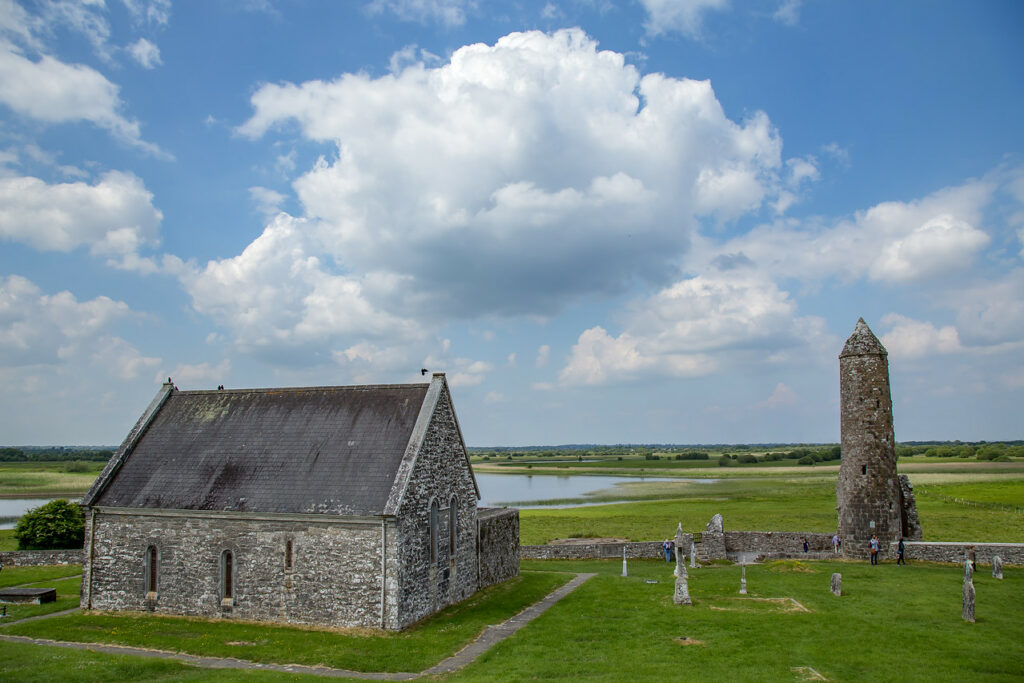
Naturally, the Vikings and Anglo-Normans plundered it numerous times, but as is the norm in County Offaly, the monks dusted themselves off and kept rebuilding. Clonmacnoise now comprises of the well-preserved ruins of a cathedral, seven churches, early grave slabs and a duo of round towers.
“If you look at the two towers — named O’Rourke and McCarthy — you’ll notice that one could fit perfectly on top of the other,” Kathy says. “There’s speculation that when the O’Rourke tower was damaged by lightning 11 years after being built, the materials were then used to form the smaller tower — an early example of recycling!”
Other highlights are the three high crosses, decorated mainly through religious figures and images — and now protected from the vagaries of Irish weather in the excellent visitor centre.
SETTING SAIL
Nearby is the village of Shannonbridge, where I discover Lukers’ delightful 17th-century bar, a 16-arch bridge, and a stunning Napoleonic fortification. 20 years ago, local Fergal Moran and his wife, Linda, beautifully restored the main building, which now doubles as a café and gift shop. The museum upstairs documents the rise of these structures across the island in the early 19th century when the British feared invasions by Napoleon’s France.
Fergal tells me the fortification has been an integral part of his family’s history — “three generations have worked here, and I just want to keep this wonderful building alive and open to the public.”
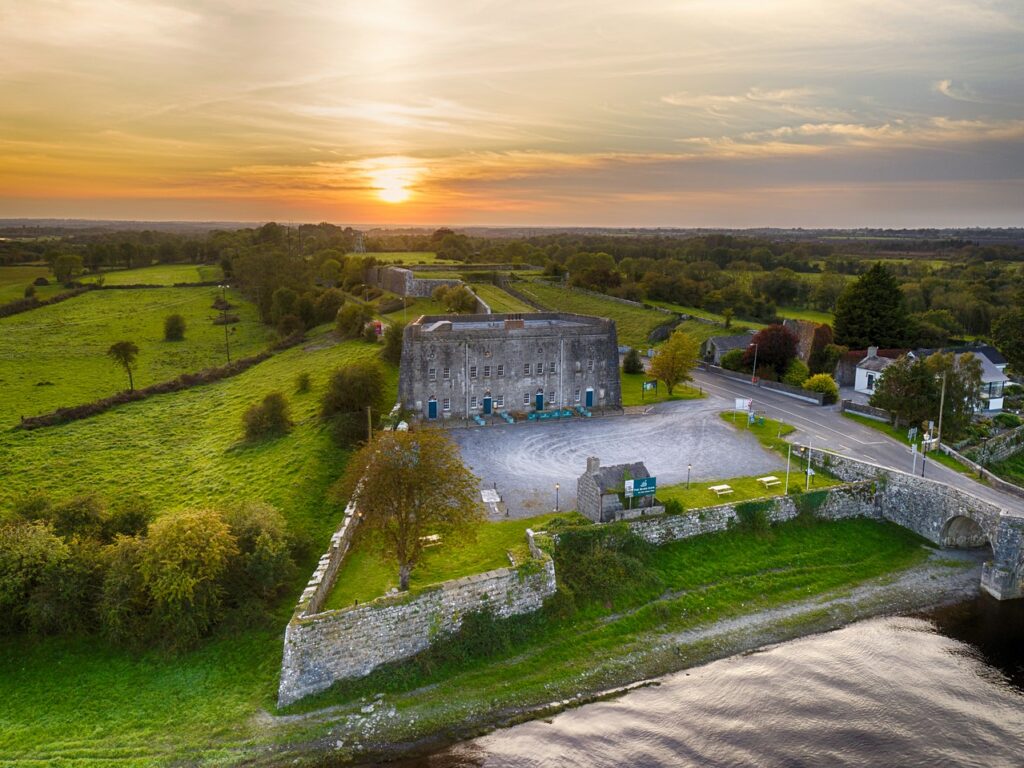
Family is also central to the next stop on my itinerary. Founded 50 years ago by the late Brendan Smyth and his wife Mary, Silverline Cruisers, based in Banagher, has blossomed into one of the premium cruising rental companies on the Shannon. The second generation, Barbara and Morgan, are currently steering the company into the future.
“What’s great about Ireland is that there’s no license required to sail here,” Barbara tells me as one of her team members, Evan, brings us out onto the Shannon — the country’s main waterway, imbued in history, heritage and culture.
As I observe the wildlife larking about the callows framing the route, Barbara says, “sailing is a different way to explore Ireland”. She adds that her clients come from all over the world, including Austria, Germany and Switzerland, attracted to slow-paced holidays that involve “fishing, water sports, wildlife, chatting to locals and singing in the pubs. Basically, the Irish way of life!”
The company’s boats are equipped with modern conveniences, including central heating, gas cookers and hot showers. Evan, currently training as a schoolteacher, adds that Banagher is ideally situated as sailors “have the pick of destinations to explore — it’s more or less in the middle of Shannon.”
Back on terra ferme, I check into my lodgings for the evening — the four-star Tullamore Court Hotel, a recent and deserved winner of the prestigious Midlands Overall Hotel of the Year award, thanks in no small part to their family-friendly facilities, including a 20-metre pool.
The sprawling interior is a treasure trove of imaginative flourishes — notably the Furlong Bar, complete with floral ceiling displays and art deco furniture. Here, I enjoy Supreme of Chicken followed by homemade cheesecake, all of which I greedily devour — I blame my earlier sailing expedition for working up an appetite!
My bedroom is the presidential suite. Spanning 48 square metresand two separate rooms — with a balcony offering panoramic views of Tullamore — it’s one of the largest spaces I’ve ever stayed in. Not that I’ve too much time to explore it, being unable to resist the draw of the Jacuzzi and cloud-like bed.
SCIENCE ROYALTY
The following morning, fully rested, I head south and visit the delightful Georgian town of Birr. Its centrepiece — the castle — started as a 12th-century Norman structure, but it has been significantly developed since then. Firstly, by the O’Carroll family and then, over the past 400 years, the multi-talented Parsons — the earls and countesses of Rosse. The seventh generation of this family lives here today.
In addition to the castle, the extensive grounds showcase the best Mother Nature has to offer, including the world’s tallest box hedge. Most impressively, this estate has been a shining light in the science world thanks to the Parsons.
“So many trailblazers and visionaries have lived here,” my guide, Colm, praises. “It was well and truly an international centre of science and astronomy.”
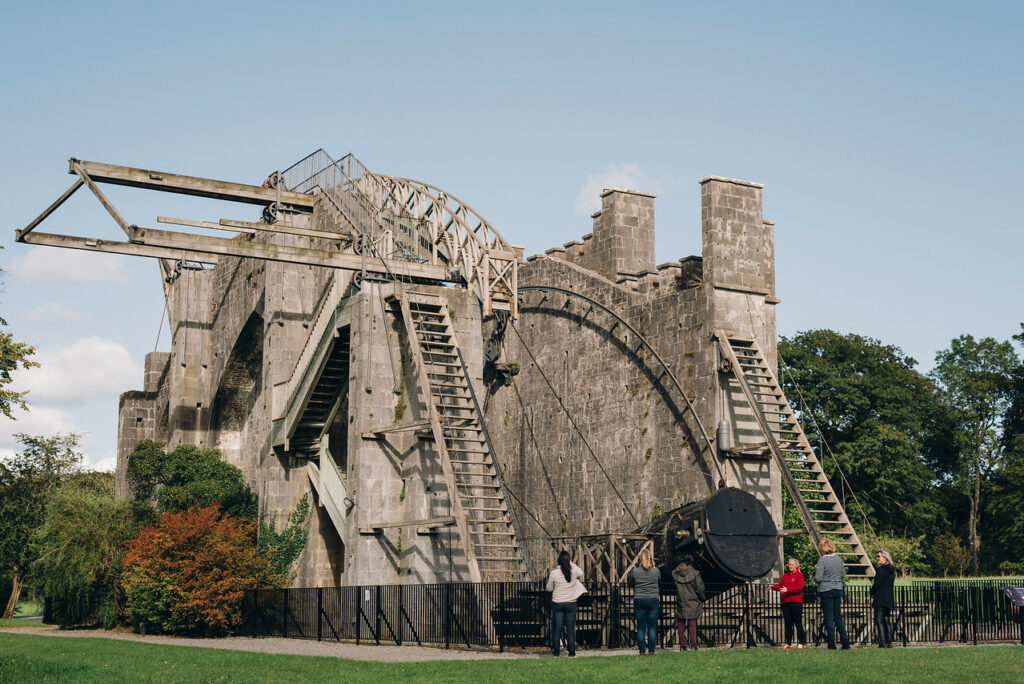
The Parson’s list of achievements, documented in their science centre, is long and extensive. Renowned inventions originating here include the world’s first suspension bridge and the Leviathan of Parsonstown — a reflecting telescope, once the largest in the world, built in 1845 by William, the third Earl of Rosse. The castle houses the world’s oldest surviving example of a darkroom, created by William’s wife, Mary, an eminent photographer.
Their son, Laurence, clearly inherited their scientific mind and created the Lunar Heat Machine, which measured the heat of the moon. His findings were discredited in his lifetime but were proven correct following the moon landing in 1969.
“Afterwards, Neil Armstrong sent the family a letter, thanking them for their extraordinary input into astronomy and scientific exploration,” Colm tells me. “The family cherishes it.”
He says the letter concludes with the line: “With all good wishes and appreciation for the contributions of an astronomical family. Apollo 11.”
But it wasn’t just science royalty who frequented Birr Castle. Antony Armstrong-Jones was partly brought up in the castle — he’d later become known as Lord Snowdon after marrying Queen Elizabeth’s sister, Princess Margaret.
The lovebirds visited the castle after their wedding — although Colm reveals that in advance of the V.I.P. visit, their enthusiastic hosts decorated the bedroom directly above the boiler room to guarantee warmth. Despite the castle’s scientific legacy, they failed to realise that the heat would result in the new wallpaper falling on top of the newlyweds!
OLD-WORLD CHARM
The wallpaper, firmly fixed to the walls, is one of the many decorative highlights in my accommodation in Birr, The Stables — a boutique guesthouse that defines old-world charm. A mecca for fashion, gourmet food and accommodation, this elegant, 19th-century property is one of many striking buildings on the tree-lined Oxmantown Mall, designed by the second Earl of Rosse.
“Our five period-style guest rooms offer a special overnight experience,” says owner Caroline Boyd. “Each room has original, Georgian Town House high ceilings and sash windows looking out onto Oxmantown Mall or the Courtyard.”
It’s difficult to overstate how beautiful this multi-purpose property is — made even more special by the warm welcome I receive from Caroline’s team.
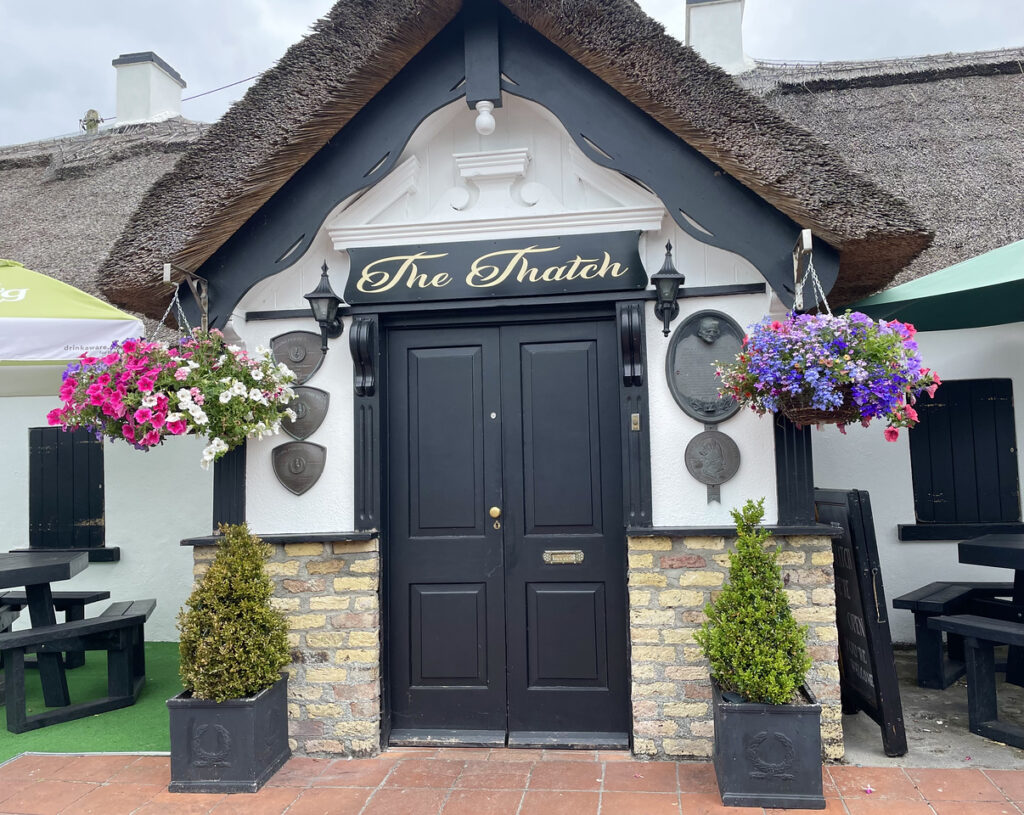
That evening, I dine in the 200-year-old Thatch restaurant in the nearby village of Crinkill. Owner Des Connole — the fifth generation to oversee the picture-perfect bar and restaurant — tells me that “the recent investment in tourism in the county has been a huge success. We’ve diners from all over the world who are no longer just passing through. They’re surprised by all that’s on offer here.”
FROM PHOENIXES TO PYRAMIDS
On my final morning in County Offaly, I receive exactly that – a surprise! When I visit the village of Kinnitty, located at the foot of the Slieve Bloom Mountains, I discover an Egyptian pyramid! Constructed in the 1830s by architect, engineer and former Kinnitty Castle owner Richard Wellesley-Bernard following a trip to Egypt, the structure is a miniature replica of the Pyramid of Cheops. It doubles as the burial tomb for six members of his family.
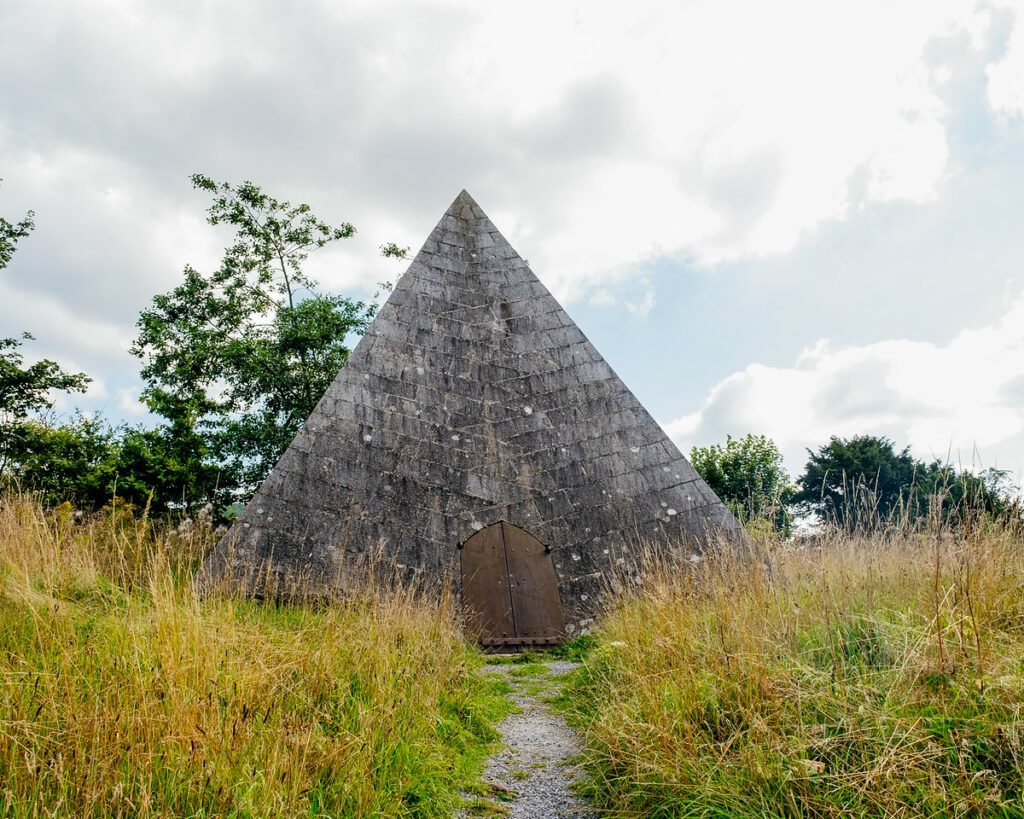
But this isn’t the only unusual structure in County Offaly. After channelling its inner phoenix, a former commercial bog has reimagined itself as Lough Boora Discovery Park. Not only is it home to various species of birds, wildlife and fish-filled lakes, but it also includes a permanent exhibition of 24 outdoor sculptures — inspired by the surrounding environment and its industrial legacy. Sitting alongside the striking landscape — and providing pops of excitement for hikers and cyclists — are locomotives, rail lines and, of course, another pyramid.
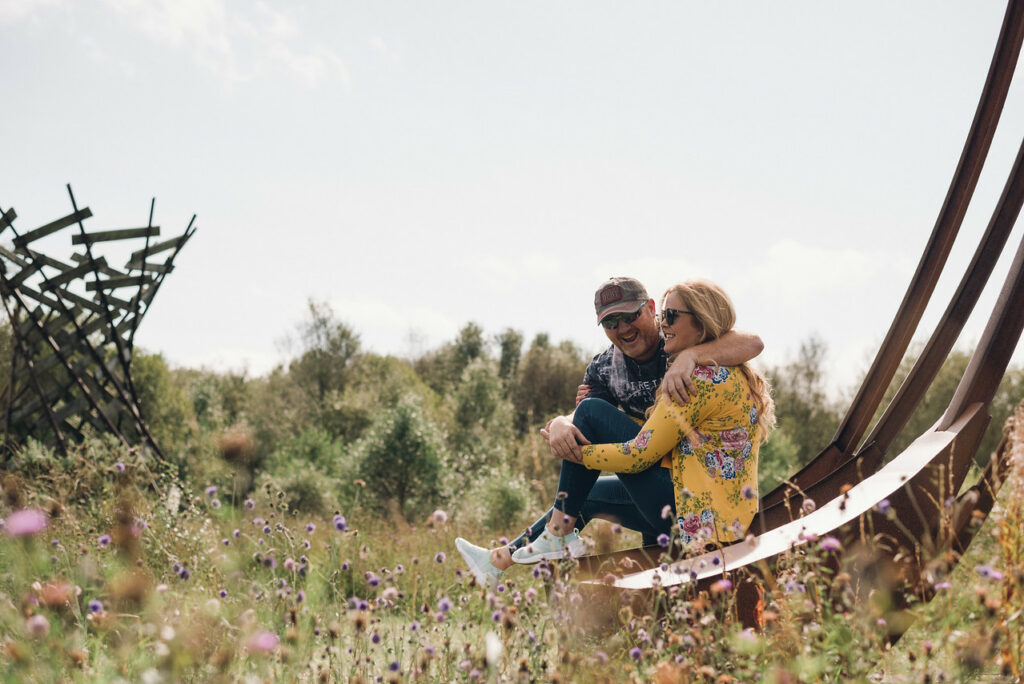
Yes, there may be influences of the Middle East scattered across the midlands, but with its unique offering, County Offaly is a pioneer, doing things its own way. For more information, see Visitoffaly.ie.
Article courtesy of Domhnall O’Donoghue, the September / October issue of Ireland of the Welcomes.
